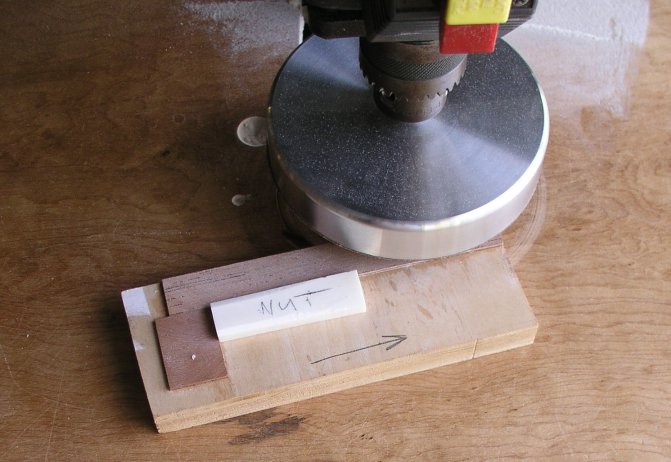|
Dirty-South Blues Harp forum: wail on! >
Exceptional video on comb flatness
Exceptional video on comb flatness
Page:
1
2
Frank
4162 posts
Apr 14, 2014
11:52 AM

|
Kinya Pollard is another excellent customizer that has some quality learning videos for the seekers of wisdom and how to be cool under pressure :)
|
smwoerner
252 posts
Apr 14, 2014
1:04 PM

|
Sanding disc in a drill press, luthiers have been doing it for years.

----------
Purveyor of Optimized New and Refurbished Harmonicas.
scott@scottwoerner.com
|
Dragonbreath
2 posts
Apr 15, 2014
10:54 AM

|
This video and discussion is very inspiring and interesting. I have collected a setup of classic marine bands and I am about to endevour on my first customization project. I have experimented with gapping and similar tweaks but I wanted to wait with sanding and sealing my harps until I get to know each harp and notice differences in air tightness and playability so I know why and what I want to customize.
So I'll be setting up the gapping primarily to have a balanced and even response on the holes I use the most.
I'll be flatsanding a little with finest grit and then sealing. Have not decided on sealant, but leaning towards polyurethane based like zar.
Do you have any pointers or suggestions on this method?
Now I have some questions on this extreme level of flat combs.
Isn't it more important that the comb matches the reedplate? Or is the reedplate flat enough?
I mean a theoretical way to go about it would be to put some pressure sensitive coat on the comb, then put on the reedplates, press together, then when plates are removed, the pressure sensitive coat would indicate spots on comb that need a little sanding as to match the surface of the reedplate.
Another question is what happens with flatness when sealent is applied? Will tjus affect comb flatness?
Is it possible to apply sealent, then when it is almost dried (non sticking but slightly soft) put on reedplates. The idea is that the sealant layer will mold perfectlt to the reedplate.
|
1847
1693 posts
Apr 15, 2014
11:07 AM

|
dragon breath, it sounds to me like you know exactly what you are doing.
are these rhetorical questions you are asking?
----------
i get a lot of request when i play my harmonica
"but i play it anyway"
|
arzajac
1341 posts
Apr 15, 2014
11:56 AM

|
Drogonbreath: These are perennial questions. In tackling this topic, it would seem that using a substance to mold and fill up the space like a gasket to be the path of least resistance until you try it.
About using a sealant to mold to a perfect fit between reedplate and comb: I've tried it all (well, I'm sure there are lots of things I haven't tried...) and nothing seems to render as satisfying an end-result as an airtight seal between all-flat surfaces. So yes, both reed plates and comb need to fit together flat.
I recently worked on some Filisko harps from the 90s. At that time, it seems he used to coat the stock Marine Band comb with silicone to create the seal you describe. Luckily, I was able to get the reedplates I needed work on off the comb without having to deal with the potential disaster that could result from ripping a sealed comb and reedplate apart.
I have also worked on a Buddha/Michalek harp he made during a period where he was experimenting with drizzling wax all over the comb to make a seal. Again, that was a bad idea. It attracts debris which will block up the slots, it's not stable and it's a royal pain to service. And calcified wax/saliva/stuff makes a cement that you need to sand down to create a seal when you reassemble.
You can also imagine the impact a gasket between the comb and reedplates has on tone, too.
But it's a learning experience to try. I highly recommend it.
About applying varnish on a flat comb, it's hard to maintain flatness. I suggest you apply the varnish like you would apply moisturizing cream on your hands - dab it on and rub it in to the wood (the lacquer, not hand cream!) Recheck flatness and re-apply. I started making my own combs out of water-resistant material because the process of keeping stock combs was slowing me down so much. I would finish working on a bunch of harps and be ready to ship them back. They would all get a final cleaning with soap and water and often enough, one comb out of the bunch would swell.
I would have to re-do that comb and delay shipment. that's why I abandoned that practice.
Also, you should try comparing an unsealed, flattened stock comb to, well, everything else... See for yourself how you like the tone and the feel of flat, unsealed Pearwood to a custom comb, or a comb you have sealed.
----------

Custom overblow harps. Harmonica service and repair.
Last Edited by arzajac on Apr 15, 2014 12:09 PM
|
Dragonbreath
3 posts
Apr 15, 2014
1:25 PM

|
1848: I have no idea but thanks to your comment i feel much more confident now and will surely do a better job!
The questions are somewhat rhetorical, I just want to understand the importance of an extremely flat comb relative to the whole system, with reedplates and sealant and screw tightening and so on.
Thank you for the advice Arzajac.
You are right, I think I want as little as possible between comb and reedplate. Harpwise, I tried all the usual suspects but held out on mb mainly because of the nailed coverplates. But when I tried one it was love at first blow, and I didn't want to tamper with the combs, I was just hoping my spitting and slobbering would seal up the harp. And I've only opened them up if a reed gap adjustment was very necessary. Now I think time has come to go through the harps and do a proper reed adjustment, drill for screws, lightly flatsand combs and perhaps seal them. I di worry about the effect this could have on sound so I might try one first as you say. And gently rubbing it in sounds good I'll go for less is more.
What's your opinion on polyurethane type if sealants?
|
arzajac
1342 posts
Apr 15, 2014
2:41 PM

|
"What's your opinion on polyurethane type if sealants?"
There are quite a few eco-friendly options and they all seem to perform well. Regardless of what you use, be sure to check the material safety data sheet to make sure you don't poison yourself.
----------

Custom overblow harps. Harmonica service and repair.
Last Edited by arzajac on Apr 15, 2014 2:42 PM
|
Frank
4163 posts
Apr 15, 2014
6:05 PM

|
Heard about this from Kinya Pollard...
"IT WORKS VERY NICELY"

Bulls Eye Shellac is an alcohol-based solution of pure lac, a natural resin secreted by tiny insects on certain trees, mainly in India.
It is available in Clear and Amber. Both dry to transparent films - the Clear has a faint, golden cast that is much lighter than oil-base finishes, while the Amber has a warm, orange cast that gives a rich, antique-look to woodwork.
Bulls Eye Shellacs are manufactured using technology developed by Zinsser in over a century's experience. They are uniform in quality, unmatched in shelf life, and packaged for convenience of use. All-natural Bulls Eye Shellac has many of the great performance characteristics of today’s synthetic clear finishes:
In an age of fast-drying products, few finishes dry as fast as shellac. No elaborate instructions are needed, and mistakes are easily corrected. In spite of all the wonders of 21st century clear finish chemistry, there is still no other finish that enhances the depth and natural beauty of wood grain like shellac.
Wood that has been finished with shellac looks soft and natural, not plastic-coated. The finish will not yellow or darken with age like polyurethanes, and it’s simple to maintain.
In a time when more and more consumers prefer finishes that clean up with soap and water, shellac brushes can be cleaned in all-purpose household detergents or household ammonia and warm water.
Is user-friendly and virtually goof-proof
It can be applied with a brush, pad, sprayer, or wiping cloth
Good results are almost guaranteed
Wood that has been finished with shellac looks soft and natural
The finish will not yellow or darken with age
Last Edited by Frank on Apr 15, 2014 6:07 PM
|
STME58
758 posts
Apr 15, 2014
10:20 PM

|
Shellac is even edible. I is sometimes used in fancy deserts to give them a bit of a shine. It also used to be used by bicycle track racers to hold their tubular tires to the rim.
|
florida-trader
451 posts
Apr 16, 2014
6:53 AM

|
Here are a couple of tips with regard to working with wood combs. I learned these lessons the hard way so I hope this saves you from making some of the same mistakes I made.
The biggest mistake I made early on was thinking that a good coat of salad bowl finish or polyurethane would fill in and mask all my imperfections. Uh uh. It does the exact opposite – IT MAGNIFIES YOUR IMPERFECTIONS. Also I believe that sealing a wood comb is more about what you put IN the wood than what you put ON the wood. I have been using Shellac for several years to seal the wood. First I flat sand the wood comb and then I literally marinate the wood in a bucket of Shellac. Whenever you put a coating of any kind on wood it raises the grain. The tiny little microscopic fibers of wood absorb the sealant and stand up. That means after sealing the wood you have to sand it again – this time with a finer grain paper because your goal is not to remove a lot of material – just the raised fibers. I use a series of progressively finer sandpapers all the way up to 1000 grit. The end result is a very smooth nonabsorbent surface. Last I use wipe on polyurethane. A drop or two on a microfiber cloth is all it takes to get a perfect finish. No brush marks. No drips. No runs. It dries very quickly because you are putting it on in such thin coats so you can do 2 or 3 coats in pretty short order. If you spend the time up front to get the wood sanded perfectly smooth you don’t need much in the way of a polyurethane finish. You’re just adding a thin layer of protection that adds a little gloss. By the way, on my Corian, Acrylic, Hogany and Brass combs I go all the way up to 8,000 grit polishing paper to give them a beautiful finish since I will not be adding any polyurethane when I’m done.
----------
Tom Halchak
www.BlueMoonHarmonicas.com
|
droffilcal
67 posts
Apr 16, 2014
12:56 PM

|
After reading this thread I am thouroughly convinced that aftermarket combs are generally under priced, perfectly flat or not..............
|
Post a Message
|